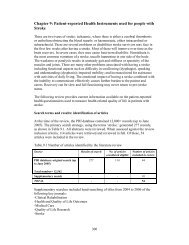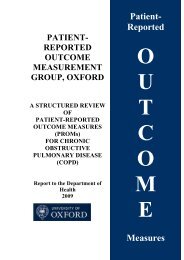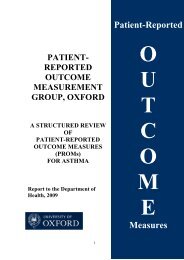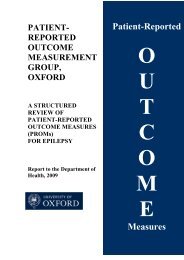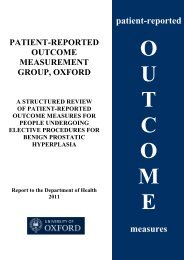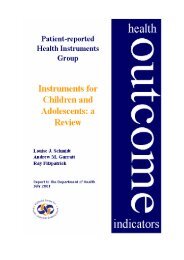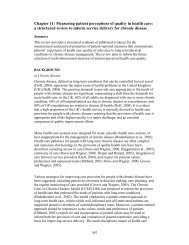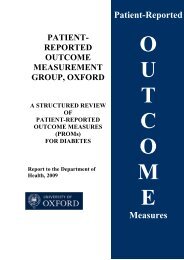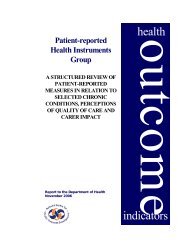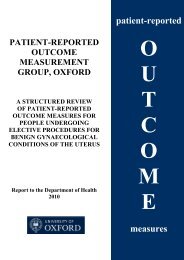2010 review - Patient-Reported Outcomes Measurement - University ...
2010 review - Patient-Reported Outcomes Measurement - University ...
2010 review - Patient-Reported Outcomes Measurement - University ...
You also want an ePaper? Increase the reach of your titles
YUMPU automatically turns print PDFs into web optimized ePapers that Google loves.
medical therapy for patients with chronic stable CAD (Boden et al., 2007), and the procedure<br />
would appear to be inappropriate for asymptomatic patients, or those with minimal<br />
impairment (Curtis & Krumholz, 2004). It may also be less effective in terms of quality-oflife<br />
and cost benefits if repeat revascularisation is required, and in patients with multi-vessel<br />
disease (Poulin et al., 2007; Pusca & Puskas, 2007).<br />
Aims of the report<br />
The aims of this report are to identify <strong>Patient</strong>-reported Outcome Measures (PROMs) which<br />
have been evaluated with patients undergoing an elective coronary revascularisation<br />
procedure (ECRP) and to provide recommendations to the Department of Health (DH) of<br />
PROMs for ECRP that could potentially be used on a large-scale population basis, combining<br />
good measurement properties with the likelihood of modest burden to respondents in order<br />
not to jeopardise response rates.<br />
Structure of the report<br />
The methods of the <strong>review</strong> and the results of the search are described, including sources and<br />
search terms used to identify relevant published research. Details of this evidence are<br />
presented for preference-based measures, generic health status measures, and condition or<br />
procedure-specific PROMs evaluated with people with coronary heart disease undergoing<br />
elective procedures for coronary revascularisation. The full body of evidence and a short-list<br />
of PROMs were presented to a multidisciplinary panel for comment; details of their<br />
comments and ratings are reported in Appendix D. The PROMs Group considered the<br />
combination of the <strong>review</strong> of evidence and the views of the multidisciplinary panel before<br />
reaching its own conclusions and recommendations (Section 5).<br />
Methods<br />
Methods adopted were as described in previous <strong>review</strong>s performed by the PROM group,<br />
Oxford. Comprehensive searches were conducted; articles retrieved were assessed for<br />
relevance and evidence of measurement performance and operational characteristics<br />
abstracted for each PROM identified.<br />
a) Search sources and terms<br />
Several sources were searched to identify relevant articles.<br />
The primary source of evidence was the bibliographic database compiled by the PROM<br />
group in 2002 with funding from the Department of Health and hosted by the <strong>University</strong> of<br />
Oxford. In 2005, it became the property of the NHS Information Centre for Health & Social<br />
Care. The PROM database comprises over 16,000 records (available online at<br />
http://phi.uhce.ox.ac.uk). The titles and abstracts of these, as well as a further 14,000 records<br />
identified as potential inclusions, were searched using the terms ‘cardiovascular OR cardiac<br />
OR coronary OR heart’ AND ‘surgery OR revascularisation OR revascularization OR<br />
coronary artery bypass OR CABG OR CABS’ OR ‘angioplasty OR percutaneous OR PCI<br />
OR PCTA OR PTCA OR stent* OR stenting’.<br />
Supplementary searches included scanning the reference lists of <strong>review</strong> articles and others,<br />
checking instrument websites, where found, and drawing on other bibliographic resources.<br />
5



